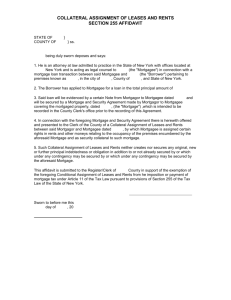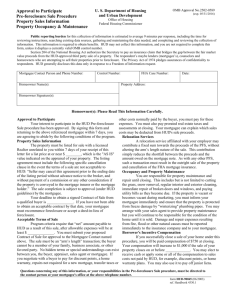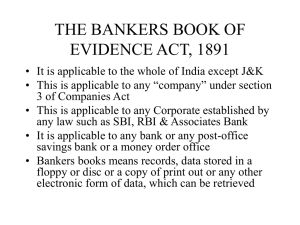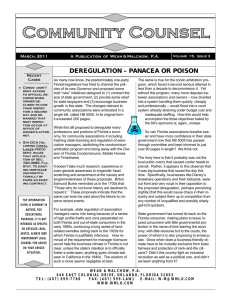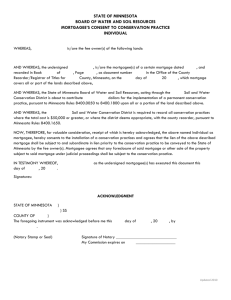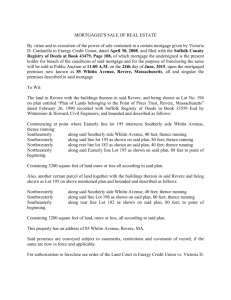11.21 - Conveyancing Handbook
advertisement
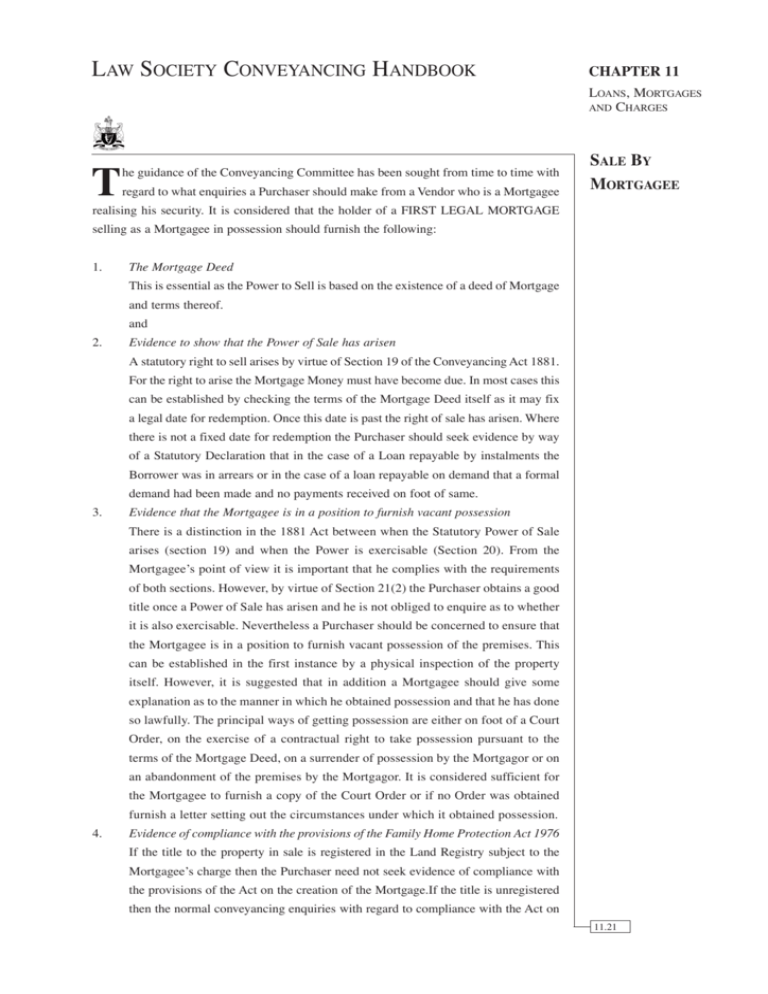
LAW SOCIETY CONVEYANCING HANDBOOK CHAPTER 11 LOANS, MORTGAGES AND CHARGES T he guidance of the Conveyancing Committee has been sought from time to time with regard to what enquiries a Purchaser should make from a Vendor who is a Mortgagee SALE BY MORTGAGEE realising his security. It is considered that the holder of a FIRST LEGAL MORTGAGE selling as a Mortgagee in possession should furnish the following: 1. The Mortgage Deed This is essential as the Power to Sell is based on the existence of a deed of Mortgage and terms thereof. and 2. Evidence to show that the Power of Sale has arisen A statutory right to sell arises by virtue of Section 19 of the Conveyancing Act 1881. For the right to arise the Mortgage Money must have become due. In most cases this can be established by checking the terms of the Mortgage Deed itself as it may fix a legal date for redemption. Once this date is past the right of sale has arisen. Where there is not a fixed date for redemption the Purchaser should seek evidence by way of a Statutory Declaration that in the case of a Loan repayable by instalments the Borrower was in arrears or in the case of a loan repayable on demand that a formal demand had been made and no payments received on foot of same. 3. Evidence that the Mortgagee is in a position to furnish vacant possession There is a distinction in the 1881 Act between when the Statutory Power of Sale arises (section 19) and when the Power is exercisable (Section 20). From the Mortgagee’s point of view it is important that he complies with the requirements of both sections. However, by virtue of Section 21(2) the Purchaser obtains a good title once a Power of Sale has arisen and he is not obliged to enquire as to whether it is also exercisable. Nevertheless a Purchaser should be concerned to ensure that the Mortgagee is in a position to furnish vacant possession of the premises. This can be established in the first instance by a physical inspection of the property itself. However, it is suggested that in addition a Mortgagee should give some explanation as to the manner in which he obtained possession and that he has done so lawfully. The principal ways of getting possession are either on foot of a Court Order, on the exercise of a contractual right to take possession pursuant to the terms of the Mortgage Deed, on a surrender of possession by the Mortgagor or on an abandonment of the premises by the Mortgagor. It is considered sufficient for the Mortgagee to furnish a copy of the Court Order or if no Order was obtained furnish a letter setting out the circumstances under which it obtained possession. 4. Evidence of compliance with the provisions of the Family Home Protection Act 1976 If the title to the property in sale is registered in the Land Registry subject to the Mortgagee’s charge then the Purchaser need not seek evidence of compliance with the provisions of the Act on the creation of the Mortgage.If the title is unregistered then the normal conveyancing enquiries with regard to compliance with the Act on 11.21 LAW SOCIETY CONVEYANCING HANDBOOK CHAPTER 11 LOANS, MORTGAGES AND CHARGES SALE BY creation of the Mortgage should be made. MORTGAGEE Once the provisions of the Act have been complied with on the creation of the Mortgage the Mortgagee in enforcing his security on foot of the said Mortgage does (Contd.) not require the consent of the Mortgagor’s spouse to the disposal. A Mortgagee is not a spouse and the conveyance from the Mortgagee is not a Conveyance within the meaning of Section 3 of the Act. There is accordingly no need for a Family Home Declaration in respect of the Conveyance itself. However it is necessary to enquire as to compliance with the Act on the occasion of the Mortgagee obtaining possession. Where possession is obtained on foot of a Court Order, before the Court makes the Order it seeks evidence of notification of the Mortgagor’s spouse pursuant to Section 7 of the Act to give the Spouse an opportunity of paying the arrears. Accordingly the interest of the Spouse is protected where a Court Order has been made. Where Possession is obtained on foot of a contractual right to possession and without the benefit of a Court Order the Mortgagee should furnish by way of a Solicitor’s Certificate evidence that the appropriate Notice under Section 7 was served on the Spouse. If there is a surrender or abandonment of possession the Mortgagee should furnish a Solicitor’s Certificate that before effecting any sale an appropriate Notice was served on the Spouse. 5. Puisne Mortgages If the holder of a First Legal Mortgage is selling as Mortgagee in possession pursuant to his Statutory Powers of Sale then by virtue of Section 62 (10) of the Registration of Title Act 1964 and Section 21 (1) of the Conveyancing Act 1881 the Purchaser takes free of all Estates, interests or rights ranking in priority after the first Legal Mortgagee and there is no need to furnish formal Discharges or Releases of any Mortgages, Judgement Mortgages or other Burdens ranking subsequent to the first Legal Mortgage. 6. Nominal Reversion Traditionally where there was a Mortgage by sub-demise it was the practice to include a provision whereby the Borrower appointed the Society or its Agent as his Attorney for the purpose of conveying the nominal reversion in the event of an enforced sale. Such a provision is no longer necessary as Section 80 of the Landlord and Tenant Act 1980 provides that if land the subject of a Mortgage by sub-demise, either created before or after the commencement of the Act, is being sold for the enforcement of the Mortgage then the Purchaser is deemed to have acquired the interest of the lessee for the entire of the unexpired term of the Lease including the period of the nominal Reversion. Form of Assurance from Mortgagee The operative part of a Deed of Assurance from a Mortgagee in possession should take the 11.22 LAW SOCIETY CONVEYANCING HANDBOOK CHAPTER 11 LOANS, MORTGAGES AND CHARGES Registered Land SALE BY MORTGAGEE Section 62 of the Registration of Title Act 1964 deals with the Power of Sale by a (Contd.) following form: 1. Mortgagee and Form 25 of the Land Registry Rules lays down the format of the Deed of Transfer whether the property is leasehold or freehold and the operative part is as follows: “A being the Registered Owner of a Charge registered on the ....... day of ....... 19 ....... (or at Entry No .......) in exercise of the Power of Sale hereby transfers ....... discharged from the said Charge and from all other Burdens entered in said Folio of the Register over which the said Charge ranks in priority ....... ” 2. Unregistered Land In addition to the normal recitals the Mortgage Deed should be recited and the fact that the Mortgagee is selling as Mortgagee in possession. The operative words and habendum will be as follows: (i) Unregistered Freehold “AB as Mortgagee in exercise of the Powers vested in it by virtue of the said Mortgage and the Statute or Statutes in that behalf and of every other Power them enabling hereby GRANT and CONVEY unto ....... “TO HOLD the same in Fee Simple free from all right or equity of redemption and from all claims and demands under the said Mortgage” (ii) Unregistered Leasehold AB as Mortgagee - As No.(i) above - assign rather than convey: “TO HOLD the same for all the residue now unexpired of the said term of years granted by the Lease subject to the payment of the said yearly rent and to the performance and observance of the covenants on the part of the Lessee and conditions therein reserved and contained free from all right or equity of redemption and free from all claims and demands under the said Mortgage”. Having regard to the provisions of Section 80 of the Landlord and Tenant (Amendment) Act 1980 the foregoing is sufficient whether the Mortgage was by way of Assignment of the Leasehold interest or sub-demise. There is no longer any need to join an Attorney for the purpose of passing the nominal reversion. This is the case whether or not the Mortgage Deed itself provided for the appointment of an Attorney for this purpose. In the case of Leasehold Property (whether Registered or Unregistered) the Deed of Assurance should contain the usual covenant by the Purchaser to pay the rent reserved by the lease and to perform and observe the covenants on the part of the Lessee and the conditions contained therein. Published in Law Society Gazette, September 1989 W here a mortgage is redeemed the title documents must be returned to the mortgagor. 11.23
